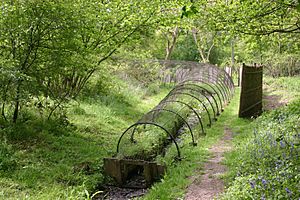Boarstall Duck Decoy facts for kids
The Boarstall Duck Decoy is a special old structure in Boarstall, Buckinghamshire, England. It was built a long time ago, in the 1600s! Today, it's looked after by the National Trust, a group that protects important places and nature.
Contents
What is a Duck Decoy?
A duck decoy is a clever trap designed to catch many waterfowl, like ducks. Long ago, these decoys were common across the English countryside. But now, only four of them are still left! The Boarstall Duck Decoy is one of these rare survivors. It still works today and is surrounded by a beautiful woodland area about 13 acres (53,000 m2) in size.
How Does the Boarstall Decoy Work?
The main goal of a duck decoy is to catch birds without harming them. It uses a special pond with a long, cone-shaped tunnel. This tunnel is made from wickerwork, which is like woven branches.
To attract birds, a fake duck, called a "decoy," is placed on the water. Once real ducks come close, a person called a "decoyman" works with a trained dog. The dog helps to gently guide the birds towards the tunnel. The ducks then swim into the narrow tunnel, where they can be safely caught.
Why Were Duck Decoys Used?
Originally, the birds caught at places like Boarstall were used as a source of food. Catching ducks this way had a big advantage over simply shooting them. Ducks caught in the decoy did not have any metal pellets or lead shot in their bodies. This meant they were cleaner and could be sold for higher prices.
What Happens at the Decoy Today?
Today, the Boarstall Duck Decoy is no longer used for catching food. Instead, the National Trust organises special demonstrations. Any birds that are caught during these demonstrations are not harmed. They are instead ringed with a small tag on their leg. This helps scientists who study birds, called ornithologists, learn more about them.


